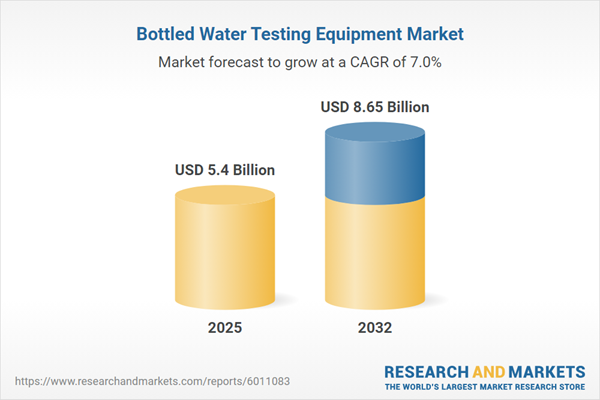Speak directly to the analyst to clarify any post sales queries you may have.
The bottled water testing equipment market is evolving rapidly as companies intensify efforts to uphold quality standards and keep pace with increasingly complex regulations. Senior decision-makers are focusing on technological advances and improved operating strategies to maintain competitive advantages throughout global supply networks.
Market Snapshot: Bottled Water Testing Equipment Market Overview
The bottled water testing equipment market grew from USD 5.04 billion in 2024 to USD 5.40 billion in 2025, recording a compound annual growth rate of 6.96%. This momentum stems from rising adoption of advanced analytical tools and increasing emphasis on stringent quality assurance. Market leaders are accelerating modernization and aligning with shifting regulatory requirements worldwide. Integrated, data-driven operational methodologies are enabling proactive oversight, supporting the sustained trust of consumers and stakeholders in a dynamic marketplace.
Bottled Water Testing Equipment Market: Scope & Segmentation
Senior executives require a clear view of market segmentation and regional nuances to inform strategic direction and resource deployment. This section highlights primary market segments and their strategic impact:
- Technology: Chromatography provides targeted substance identification, while mass spectrometry facilitates detailed contaminant detection. Spectroscopy is used for comprehensive chemical analysis, and instruments for pH and conductivity measurement allow precise real-time water quality checks.
- Product Types: Laboratory analyzers enable multi-parameter testing. Online systems support continuous monitoring. Portable units allow rapid, on-site testing. Reagent kits offer tailored solutions for specialized water safety scenarios.
- Application Areas: Solutions address analysis of inorganic and organic contaminants, microbiological assessments, and physical water parameter evaluation—critical for ensuring regulatory compliance at each stage of bottled water production.
- End Users: Food and beverage manufacturers, regulatory bodies, third-party labs, contract testing organizations, and water treatment firms are key stakeholders, each requiring compliance-driven approaches.
- Sales Channels: These include direct manufacturer agreements, distributor partnerships, and digital procurement platforms, allowing for flexible sourcing strategies adapted to varying business needs.
- Regions: North America maintains responsive regulatory approaches. Europe focuses on regulatory harmonization. The Middle East and Africa prioritize infrastructural growth, while Asia-Pacific demonstrates agile policy adaptation and promotes robust water management through government initiatives.
- Companies Profiled: Danaher Corporation, Thermo Fisher Scientific Inc., Agilent Technologies, Merck KGaA, PerkinElmer, Shimadzu Corporation, Mettler-Toledo International Inc., Waters Corporation, Metrohm AG, and Bio-Rad Laboratories, Inc.—recognized for advancing technology and shaping market standards.
Key Takeaways for Senior Decision-Makers
- Rapid adoption of mobile and real-time analytical systems enables timely risk management, supporting continuous compliance across varying regulatory landscapes.
- Strategic collaborations with external partners reduce adaptation time, providing greater resilience in addressing emerging compliance obligations.
- Integrated data analytics and automated detection tools ensure operational transparency and facilitate responsive decision-making at all business levels.
- Modular platforms and diverse procurement options contribute to scalable technology deployment, enhancing operational efficiency as enterprise needs evolve.
- Dedicated calibration and ongoing maintenance services sustain high equipment performance, minimizing downtime and supporting productivity goals.
- Region-specific compliance strategies allow organizations to align operations with local expectations, improving agility in both established and growth markets.
Tariff Impact: Navigating New US Trade Environments
Recent adjustments to US tariff structures have led to higher costs for imported bottled water testing equipment. To address these changes, companies are increasing local production, emphasizing stable supplier relationships, and refining inventory management. These measures help stabilize supply chains and reduce pricing volatility amid evolving trade conditions.
Methodology & Data Sources
This report leverages perspectives from industry executives, insights from regulatory experts, focused B2B research, and verified market intelligence. All findings are cross-checked with trade datasets and survey feedback from industry professionals to ensure relevance and accuracy for executive strategies.
Why This Report Matters
- Delivers a comprehensive understanding of bottled water testing equipment market innovations and efficient sourcing models to aid compliance initiatives in global markets.
- Presents actionable analysis on segmentation and regional variations, supporting risk management and resource deployment for industry stakeholders.
- Provides leadership teams with timely intelligence to recognize and capitalize on market opportunities as both regulation and commercial conditions shift.
Conclusion
Continual investment in advanced technologies and adaptable operations equips organizations to efficiently manage uncertainty and strengthen market presence. This approach supports sustained growth and operational reliability across the evolving bottled water testing equipment landscape.
Additional Product Information:
- Purchase of this report includes 1 year online access with quarterly updates.
- This report can be updated on request. Please contact our Customer Experience team using the Ask a Question widget on our website.
Table of Contents
3. Executive Summary
4. Market Overview
7. Cumulative Impact of Artificial Intelligence 2025
Companies Mentioned
The companies profiled in this Bottled Water Testing Equipment market report include:- Danaher Corporation
- Thermo Fisher Scientific Inc.
- Agilent Technologies, Inc.
- Merck KGaA
- PerkinElmer, Inc.
- Shimadzu Corporation
- Mettler-Toledo International Inc.
- Waters Corporation
- Metrohm AG
- Bio-Rad Laboratories, Inc.
Table Information
| Report Attribute | Details |
|---|---|
| No. of Pages | 185 |
| Published | November 2025 |
| Forecast Period | 2025 - 2032 |
| Estimated Market Value ( USD | $ 5.4 Billion |
| Forecasted Market Value ( USD | $ 8.65 Billion |
| Compound Annual Growth Rate | 6.9% |
| Regions Covered | Global |
| No. of Companies Mentioned | 11 |









